Sugar is a miraculous thing. Although so demonised these days, the complexity of this ingredient – once considered the rarest of luxuries – is far greater than those who decry ‘the white stuff’ would have us believe. For a start, it isn’t always white: those snowy crystals that you spoon into your tea (you philistine) are just the tip of the iceberg. Along the spectrum from refined white sugar to the thickest, inkiest treacle are golden-hued caster and granulated sugar, crunchy demerara, classic honeyed golden syrup, the butterscotch sweetness of light muscovado, the heady sticky toffee notes of dark muscovado, and the burnished caramel of molasses sugar. That’s not even counting variations on a theme: palm sugar, coconut sugar, rice syrup, honey, date molasses…
Read moreChristmas granola
Making granola is always a happy event in my kitchen, because it means I have time to potter around for 45 minutes whisking together delightful combinations of honey and spices and stirring huge oven trays laden with toasting, cinnamon-scented oats. It leaves the house smelling like a Scandinavian bakery for hours, and, best of all, enables me to stockpile a couple of big jars of glorious homemade granola to last me the next few weeks. Now that the festive season has arrived and I have handed in my PhD (just thought I’d casually drop that in - !!!), I thought I’d use a bit of newfound free time to experiment with a Christmassy version of this breakfast staple. It has the familiar nutty crunch of baked oats enveloped in honey, but with added seasonal twists.
Read moreFifteen Christmas gift suggestions for food-lovers
I know that Christmas gift suggestions are rife at the moment, and that providing a list of ideas for ‘the foodie in your life’ is hardly original. But this is slightly different, firstly in that it in no way claims to be directed at any ‘foodies’, given that the term is an abomination and a plague upon the English language, and secondly in that this is a list compiled from my own personal experience, rather than from whatever has caught my eye in the numerous catalogues and PR emails doing the rounds at this time of year. It’s essentially a collation of food-related items that I own and love, and would love to have received (or did in fact receive) at some point in my life under the Christmas tree. There are also some suggestions for homemade food-based gifts that are guaranteed to please almost any audience. I haven’t been asked to promote these brands or items, incidentally – they are recommendations based on things I genuinely love or find useful. So here they are: fifteen ways to make someone who likes food happy.
Read moreSpiced pear, quince and cranberry compote
This tastes like Christmas, although I definitely wouldn’t save it just for the coldest moments of the year. Simmering fragrant quinces and perfumed pears in a cranberry syrup, rich with warming spices and scented like mulled wine, gives them a luscious, melting tenderness. Add some tart, bouncy dried cranberries you have a wonderful textured mass of sweetness and spice. The colours are muted, but beautiful in their own right: deep amber, dusky pink, ochre-tinged cream, a tangle of tender poached fruits, occasionally punctuated with the ebony blade of a star anise or shard of cinnamon quill.
Read moreFestive apple jelly
The word ‘jelly’ fills me with a little bit of horror. Firstly, it conjures up images of lurid children’s birthday party food, weirdly fluorescent transparent goo in odd shapes that wobbles under the pressure of a spoon or a fat youthful finger. I’ve never liked jelly or even tried it, as I recall; I think I’m afraid of the strange way it would feel in my mouth, not solid but not quite liquid either, trampolining oddly against the teeth. I have an irrational aversion to the stuff.
Read moreMerry Christmas!
I'd like to wish all my readers a very merry Christmas. Naturally, I hope your Christmas is full of delicious things to eat as well as happy times with friends and family. I for one have started my day with a delicious bowl of pear and cranberry baked oatmeal and a cup of spiced Christmas tea. There's a huge, majestic rib of beef sitting proudly on the worktop waiting to come to room temperate before it goes into a searing oven; there's smoked salmon in the fridge, to be eaten with butter, horseradish and soda bread; there are mini sausage rolls waiting to puff up and go gloriously golden in the oven, mulled wine to sip around the fire, and - of course - a huge array of vegetables waiting to be peeled. I'd better go and get back to the kitchen.
I leave you with a festive picture of my cat in the snow. It's not snowing here, just doing that standard British grey drizzle thing, so I thought I'd bring a little feline-based snowy joy into your lives.
Merry Christmas!
Orange and pistachio stollen squares
Christmas in the kitchen, for me, is a time to start searching for those 'definitive' recipes. Seeing as the annual festival of getting fat and eating too much with some exchanging presents in between generally involves cooking the same dishes every year - mince pies, Christmas pudding, a roast, cabbage, sprouts, Christmas cake, cranberry sauce - I've been on the hunt for the past few years for recipes for these things that are so good I'll want to just go straight back to them next year, rather than continuing to experiment. So far, Delia's braised red cabbage with apple, Levi Roots' tropical Christmas pudding and Fiona Cairn's Christmas cake recipes are all lucky enough to have made it onto this list. My mum's mince pies are also a staple, but I long ago accepted that they'll only taste right if mum makes them herself, so they're not something I can really recreate on my own.
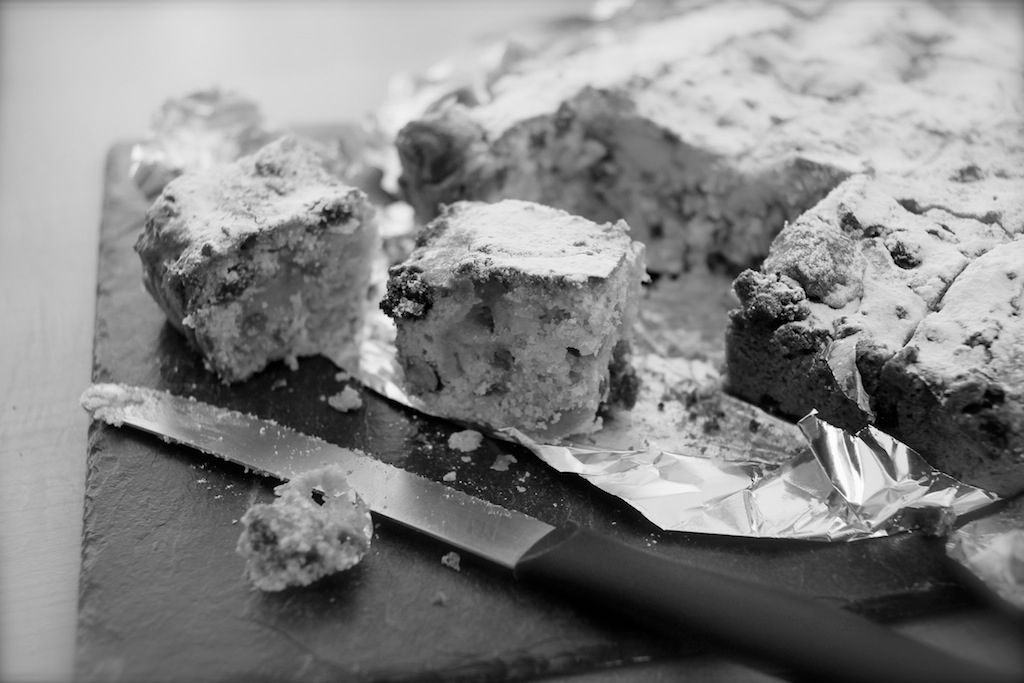
However, there's still a gap as far as stollen is concerned. Ever since I discovered this baked delight a few years ago - I can't actually remember when I had my first taste, but it had me hooked - I've tried every year to create the perfect stollen. For those of you who have never tried it, sort this out. It's a delicious cross between a bread and a cake, studded with dried fruit and nuts, with a thick vein of marzipan running through the middle. It's often glazed with butter and liberal amounts of icing sugar, and scented with spices like cardamom and cinnamon.
The first recipe I tried was from a book that came with our bread-making machine at home. I made the fruity dough in the breadmaker, stuffed it with marzipan and baked it. The result was rather like a giant, elongated hot cross bun. It was bready rather than cakey, with quite a loose crumb. It was delicious, especially toasted and buttered, but not really what I was after. Stollen should have quite a dense texture, closer to bread than cake. It's moist yet crumbly at the same time, often from the addition of ground almonds.
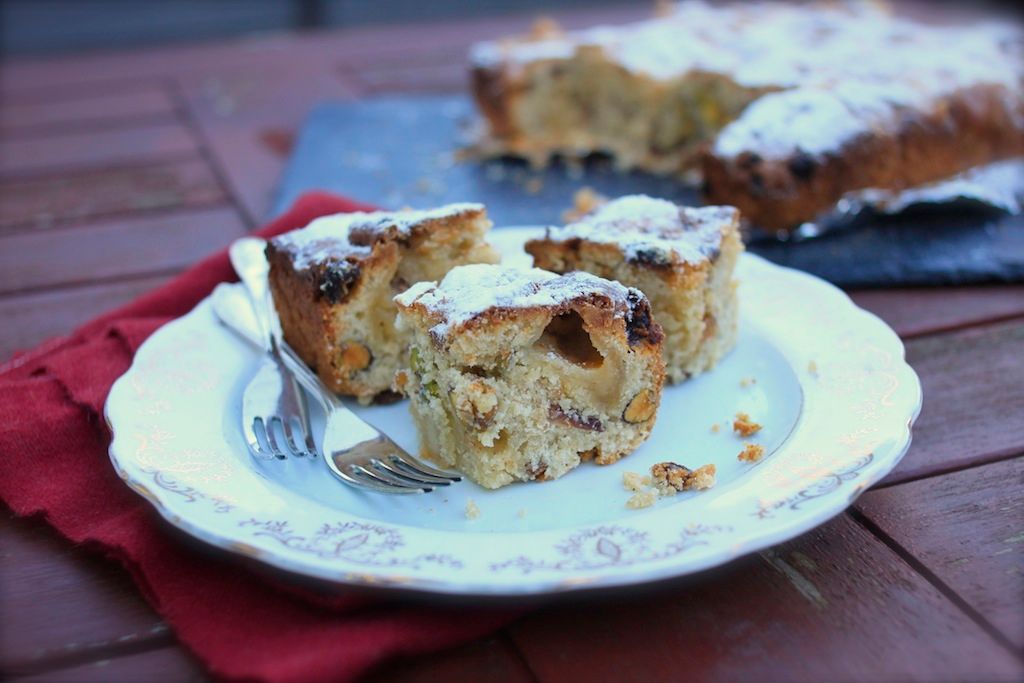
The next recipe I tried was Dan Lepard's sour cherry stollen. This was much closer to what I wanted: it had a lovely cakey texture and was even better after maturing, soaked in rum, sugar and butter, for a few days (although I obviously had to nibble a piece before I put it away for its little rum bath, just to quality control). It had a lovely cardamom flavour, which I think is essential to a good stollen - the combination of super-sugary marzipan and the citrus hit of cardamom is fabulous. It's like the gastronomic equivalent of getting a snowball in the face. But in a good way.
Last year, I tried Richard Bertinet's stollen recipe, which was in the delicious magazine Christmas issue. The main advantage of this recipe was that it made not one, not two, but four stollen loaves. It was quite involved - a lot of kneading and proving and folding fruit into dough, as well as making a 'creme d'amande' out of eggs, sugar, ground almonds and butter - but the end result was gorgeous. The crumb texture was very buttery, rather like a croissant, with a wonderful almond hit. We froze two of the stollen and my mum begged me on a monthly basis throughout the following year to allow her to defrost one and eat it.
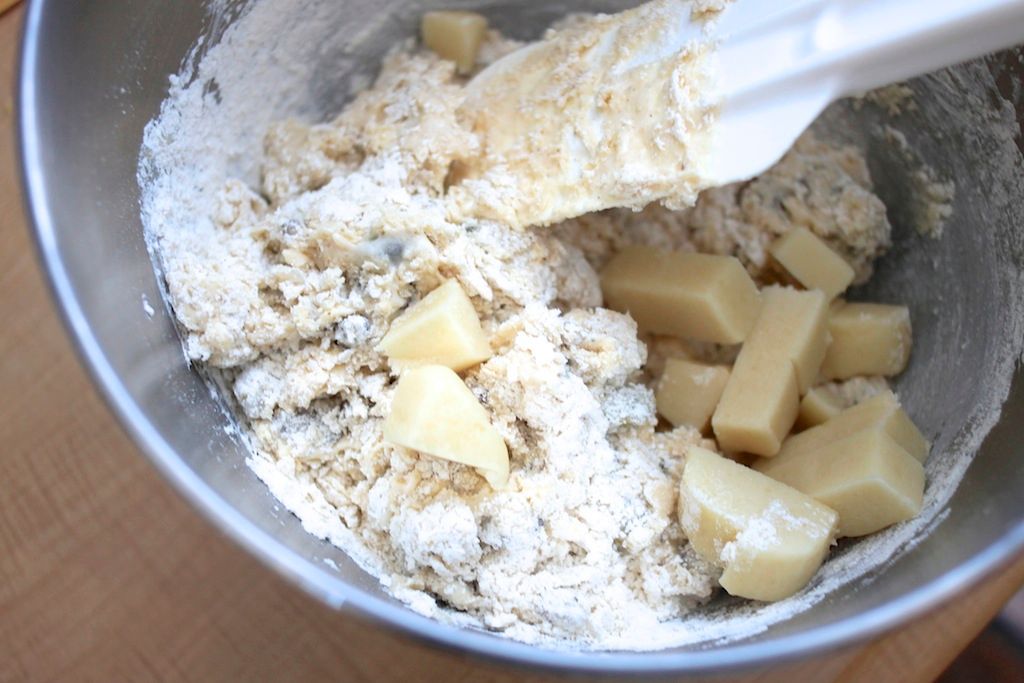
This year, I think I'll probably make the Bertinet version again. However, this recipe for orange and pistachio stollen bars, another Dan Lepard creation, has been sitting in my Bookmarks folder for an entire year, since it appeared in the 2011 Observer Christmas food special. The other day I felt the urge to bake something festive, and these sprung to mind.
The advantage of these is that they are incredibly quick and easy to make. Pretty much everything just goes into a bowl, then a pan, then the oven, then your mouth. No kneading or proving, as you often get with the more bread-like stollen recipes. Yet the end result tastes pretty much exactly like real stollen. There's that dense, cakey crumb - made with the addition of cream cheese, which I think gives it its richness - the hit of cardamom, juicy pieces of raisin, crunchy pistachios, and finally the delicious grainy squidgyness of marzipan pieces. The crumb is also infused with orange extract, which gives it a delicious Christmassy flavour.
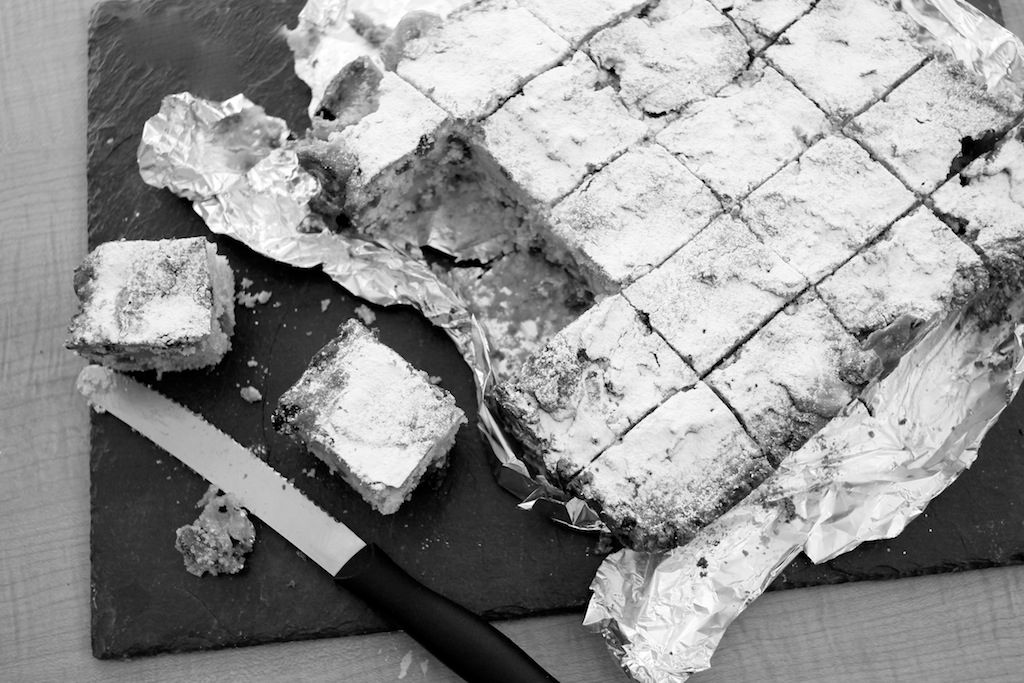
Also, because it's baked in a wide tray, you get more of the delicious crunchy, caramelised crust, which is one of the best bits of stollen. Particularly here where pieces of marzipan near the surface of the mixture bubble up in the oven and turn crunchy and toffee-like.
When I make these again, I think I'll chop the pistachios rather than leave them whole, as I prefer a little bit of crunch rather than whole nuts. I'd also chop the marzipan into smaller pieces - Dan suggests 2cm squares, but that's a sizeable chunk of marzipan to chew on, and they're also harder to fold through the batter, which is pretty dense already. [Since I wrote this post I have indeed made them again, and can confirm that chopping the nuts and using smaller marzipan pieces is definitely the way forward]. I think the raisins would be excellent replaced with dried cranberries or cherries, or maybe with some dried apricots added too.
The best part of this is removing the warm cake from the oven, then brushing it with melted butter and dousing it in icing sugar. The smell as it bakes is sumptuous, filling the kitchen with the aroma of Christmas; fruit, spice, nuts and butter. Slicing the cake into squares is also deeply satisfying, particularly when crumbs or corners end up crumbling off and you have to eat them to neaten everything up.
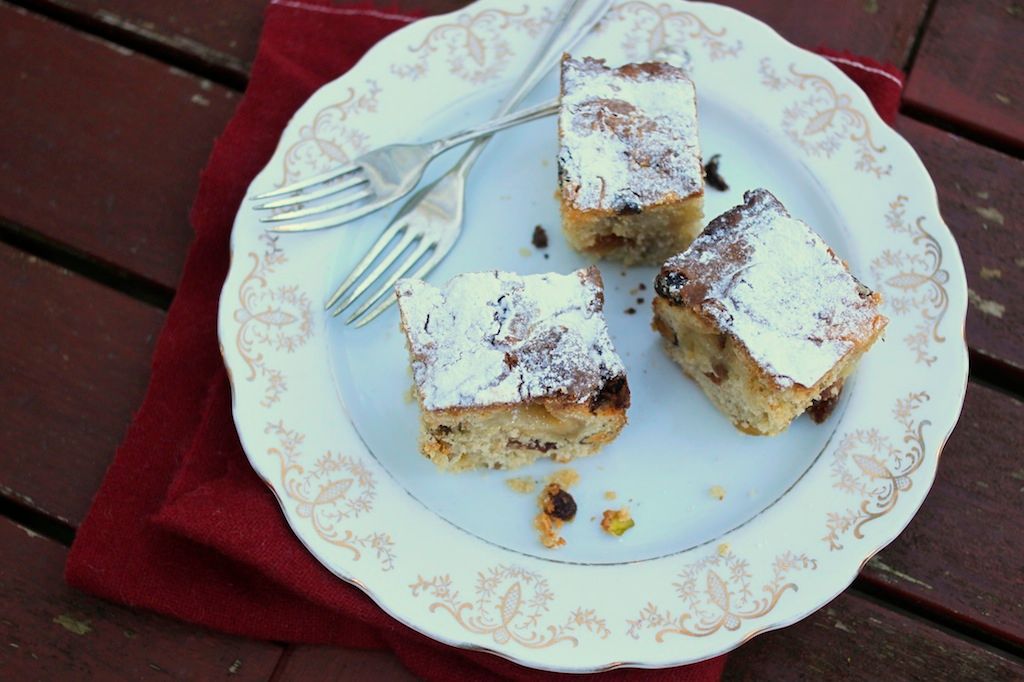
While not a true stollen, these may just make it onto my list of 'go-to' Christmas recipes. All the flavour of stollen, with none of the faff. Apparently they keep for a good while if you're generous with the melted butter and sugar, and wrap them tightly in foil. But of course, if you're generous with the melted butter and sugar, you're going to want to devour them all in an indecently short amount of time, as I did. Fortunately my department at university has an actual thing that we call 'Cake Thursday', which involves sharing home-baked treats on a weekly basis. Without these human bins in which to dispose of all my baking, I would be well on the way to obesity right now. It's cold up in York. I need baked goods for insulation.
These little squares are the essence of Christmas. Whip up a batch to sustain you through the arduous weeks of shopping, card-writing and turkey-buying ahead. Make some and give them to your friends. Just make sure they don't have a nut allergy.
For the recipe, from Dan Lepard, click here.
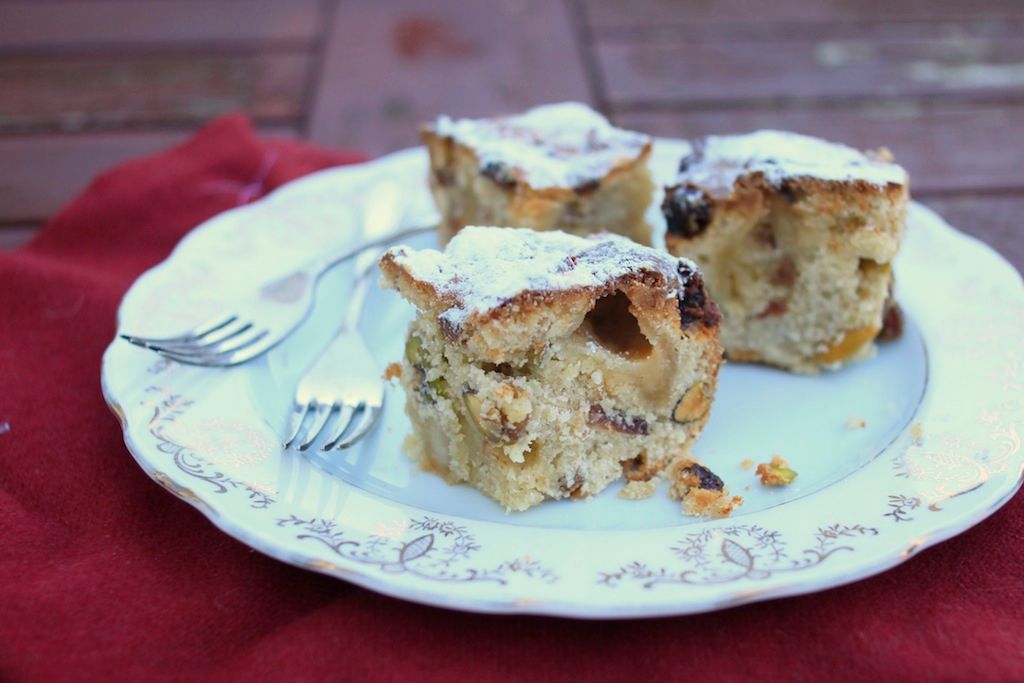
Caramelised pear, pecan and cranberry upside-down cake
So, dear readers, as we breeze inexorably into the month of June and the blossom is in full swing on the trees and the hayfever is at full saturation point in the air and the hosepipes are at full prohibition point on the lawns, I bring you the most Christmassy, un-summery cake ever.
Would you believe me if I told you that the fresh cranberries used to top this cake have been in my fridge since November?
Would you?
Probably not. Neither would I if I had told myself back then when I stashed them away for future baking. But then I discovered that cranberries have an amazingly long shelf life, largely because they have a low moisture content and a sort of waxy coating on their skins. I read that they'd last a couple of months; I didn't expect them to last nearly six.
The reason I kept some back after Christmas is mainly because I feel the humble cranberry is a bit overlooked. In fact, I feel really sorry for it. It gets its tiny little moment in the limelight, the month before Christmas where everyone feels the compulsion to make a huge batch of cranberry sauce even though no one really eats it and it doesn't go particularly well with turkey, and then it's relegated to the depths of beyond for the next year.
Why do we consign cranberries to Christmas in this country?
They have so much potential. I have the wonderful food writer Diana Henry to thank for this; in her book 'Roast Figs, Sugar Snow' she extols the virtues and versatility of cranberries, pointing out that they can be used in a wide variety of dishes; to add sharpness to a plate of meatballs or venison; to serve in a compote spooned over a slab of ginger cake; to stir through a rice salad with duck. It was her gorgeous recipes and beautiful prose that awoke me to the potential of cranberries outside the Christmas table, and that is why I tucked them away in my fridge for all those months.
She was also the reason for this cranberry and wild rice duck salad, for a lovely dinner I made involving chicken breasts stuffed with cream cheese, dried cranberries and pecans, and for my morning porridge peppered with chunks of juicy pear and gem-like dried cranberries. I'm a cranberry fiend, and I wanted to use my stash in the fridge for something really special.
I finally got round to using them this week. I've no idea why it's taken me so long...I guess there have always been higher-priority desserts on the cards.
But now that I've made this once, it's going on the 'high priority' list.
The idea for a pear, pecan and cranberry upside-down cake came from 'Roast Figs, Sugar Snow'. I'd been thinking of a cranberry upside-down cake anyway, but the slight problem with baking with cranberries is that they are extremely sour. Even if your cake batter is quite sweet, those little pockets of mouth-puckering tartness are not to everyone's taste. By toning them down a little using sugary pears and toasty pecans, you end up with a much more pleasant combination, both in terms of texture and flavour. The pears turn soft and grainy; the nuts are crunchy and earthy; the cranberries give a moreish little burst of flavour.
I love the magic of upside-down cakes and tarte tatins.
The way the fruity caramel seeps into the cake or pastry. The moment of anticipation as you flip it over and unveil it. The burnished, caramelly edges of the fruit where they've been in contact with the hot tin or pan.
You know what I love even more than that? Caramelised pears. Frying pears in a bubbling mixture of dark, ambrosial brown sugar and butter is one of the most wonderful things to spend your morning, afternoon or evening doing. The smell is intoxicating. The sight of the golden liquor is ravishing. I love the way they soften from hard, glassy, white shards into tender, slippery, curling strands of burnished sumptuousness while perfuming your kitchen with their buttery fragrance.
On the top of this cake, they melt down into sweet morsels that infuse the batter with their juice. They provide a mellow sugariness to contrast with the tart cranberries. Top it all off (literally) with the irresistible sweet, nutty flavour of pecans, and you have an addictive and delicious combination.
The cake batter for this is a healthier version of Diana's. Don't be put off. It's my standard cake batter recipe for any cake topped with fruit, and you'd never believe it only uses a fraction of the butter of normal cakes. This is down to the genius of adding yoghurt, which keeps the cake really moist and flavourful while negating the need for huge amounts of butter.
The result is a dense, vanilla-scented, moist crumb that pairs beautifully with the rich fruity topping. Seriously, it's incredible. This would work with any fruit, really, but the pear-pecan-cranberry trio is something worth trying, particularly as it looks very pretty. The cake is excellent served warm from the oven with lots of cold vanilla ice cream, but is also good just as it is with a big cup of tea. In fact, I think it's better after a day or so, when the cake becomes even more moist and the fruit tastes sweeter.
This would be the perfect cake for winter, tasting as festive and wonderful as it looks. If you're not like me and don't obsessively hoard seasonal fruits, then you could make it year-round using raspberries, blueberries, blackberries or even raisins instead of the cranberries, or use dried cranberries, or omit them altogether or change the fruit. It's up to you. Follow this basic template and you'll end up with a hugely rewarding piece of cake.
Caramelised pear, pecan and cranberry upside-down cake (serves 6-8):
(Inspired by 'Roast Figs, Sugar Snow' by Diana Henry)
- 40g butter
- 70g brown sugar
- 4 medium pears (Conference work best)
- 60g pecan nuts
- 150g fresh cranberries
- 150g light brown sugar
- 60g soft butter
- 2 eggs
- 200g plain flour
- 1 tsp baking powder
- Around 200ml plain yoghurt
- 1/2 tsp vanilla extract
- Pinch of salt
Heat the 40g butter and 70g brown sugar sugar together in a non-stick frying pan. Peel and core the pears, then cut into slices around 1cm thick. Add to the butter and sugar and cook over a medium heat until the pears soften and release some of their juice. Turn the heat up and caramelise them briefly so they are golden brown and sticky. Mix in the cranberries and pecans and turn off the heat.
Grease and line a 23cm springform cake tin, then tip the fruit mixture into the bottom. Pre-heat the oven to 180C/170C fan oven.
In a large bowl, mix together the butter and sugar with an electric mixer/hand whisk. Add the eggs, one at a time, and beat thoroughly until the mixture is pale and creamy. Sift in the flour and baking powder, then fold in the vanilla, salt and yoghurt - just enough to make a smooth batter (you might not need it all, or you might need a bit more, depending on how thick your yoghurt is).
Pour this mixture onto the fruit in the tin, then level and bake for 35-40 minutes, until golden brown and the centre springs back when you press it. Allow to cool for 5 minutes in the tin, then run a knife round the edge, put a plate over the top and invert the cake onto the plate (don't let it cool too much before you do this, or the caramel will stick to the tin).
Serve warm with ice cream, or cold for afternoon tea.
Little pear, pecan and mincemeat cobblers
I realise this post probably requires an explanation.
Because, of course, nobody in their right mind would want to be cooking, let alone eating, a cobbler right now. Nobody in their right mind would want to be eating anything at all right now. Maybe a few salad leaves and a piece of fruit. But certainly not anything involving butter, nuts or dried fruit soaked in alcohol. I think I've had enough dried fruit soaked in alcohol to last at least until next Christmas. Everywhere I go, it's there, haunting me. Mince pies. Christmas cakes (why, oh why, did I decide to make TWO?). Christmas puddings (again, I made TWO). Stollen. My body yearns for sweet release from this culinary captivity, yet somehow I can't help myself.
Generally I have pretty good willpower. I have on several occasions got up bright and early after a very late night out, having had only four hours sleep, and cycled to the swimming pool to do sixty lengths before breakfast. Last weekend, after six days skiing and a 17-hour coach journey back from the Alps (again, involving approximately four hours sleep), instead of collapsing in bed with a cup of tea, I hurried to the swimming pool (and there discovered just how many muscles I'd damaged on the slopes). I'm pretty good at saying no to sugary and enticing foodstuffs unless I'm actually hungry or have been pretty physically active that day.
But waft the aroma of a freshly baked mince pie or loaf of stollen in my face, and I am powerless.
It's a sad cycle of despair and gratification, trying to decide if the sheer momentary pleasure of biting through a flaky, buttery crust to reach a pool of molten, sweet, sticky fruit is worth the subsequent (and much less fleeting) self-loathing, paranoia, and frenetic examination of my expanding hips in the mirror.
I blame the devil on my shoulder, telling me to lighten up (ironic, considering Christmas fare is anything but light) and just enjoy the festive season instead of worrying about what a few (OK, probably about twenty) mince pies will have done to my normally OK physique.
So I am trying not to be totally neurotic about the whole thing. However, I cannot deny that I do feel replete to the point of discomfort after Christmas. It's not just the sweet stuff, but the sheer onslaught of meat I have been forced to withstand, considering I normally only eat the stuff about three times a week. Roast turkey, yes, but also sausagemeat stuffing, sausages wrapped in bacon, sprouts with a bacon and chestnut crust, a whole baked ham, Mum's homemade sausage rolls. And then, for no apparent reason, my family decided we had to have a roast rib of beef for dinner, two days after Christmas lunch. Even the carnivores in my family seemed defeated by it, and much smaller portions were had than would normally be the case if we'd eaten this lovely roast any other time of the year.
Alas. So, you're probably wondering why on earth I've been baking pear and mincemeat cobblers during this troubling time. Well, the simple answer is that I haven't, actually. I made these a week or so before Christmas, when I was still in the midst of a rapturous love affair with mincemeat, nuts, baking and autumnal fruits.
I'm sharing them with you now for two reasons. Firstly, I imagine a lot of you probably have a bit of leftover mincemeat, can't face any more mince pies, and are wondering what to do with it. Secondly, if you've managed to be a bit more restrained than myself over Christmas, a lovely fruity dessert that still packs a festive punch might be just what you fancy.
Even in my mincemeated-out state, I can tell you that these are absolutely sumptuous. They take everything that is good about a mince pie, and almost make it better. Combining chopped ripe pear with the mincemeat and adding a little lemon juice takes the strong sugary and boozy edge off it, resulting in something much fresher, lighter and - I think - tastier. The toasted pecans add a gorgeous crunch and a lovely caramelly, nutty flavour that balances the tangy mincemeat perfectly. Adding a cobbler topping means you end up with a gorgeous fluffy scone-like dough that is soft in the middle and crispy on the top, soaked around its frayed edges with rich dark juice from the mincemeat and pears.
Scoop over some cold vanilla ice cream, and you have a fabulous dessert that is reminiscent of stollen, Christmas pudding and mince pies all rolled into one. Fluffy, sticky, dark and delicious.
And, amazingly, they're not even bad for you, really. My cobbler topping contains hardly any butter, using yoghurt to thicken it, and apart from that and the suet in the mincemeat there's no fat. OK, so you'd be better off with a solitary clementine, but relatively speaking, in the context of all those other Christmas delights, these are quite healthy.
Perhaps this is the perfect post-festive dessert, after all.
Do you have any interesting uses for mincemeat other than the classic mince pies? I'd love to hear them!
Pear and mincemeat cobblers (serves 4):
- 2 large/3 medium ripe pears (I used Comice)
- 125g mincemeat
- Juice of half a lemon
- Handful of pecan nuts, toasted in a dry pan and crumbled
- 100g plain flour
- 1 tsp baking powder
- Pinch of salt
- 15g cold butter, cut into cubes
- 15g light brown sugar
- 100ml plain yoghurt or buttermilk
- 4 tsp demerara sugar
- Ice cream, to serve
Pre-heat the oven to 180C (170C fan oven).
Cut the pears into small cubes - you don't need to bother peeling them, but discard the core. In a bowl, mix them with the mincemeat, lemon juice and pecan nuts. Divide them between four 200ml ramekins (or if you don't have ramekins, just make a single large cobbler in a baking dish) and place in the oven for 10 minutes until the fruit has softened and released quite a bit of juice.
In a separate bowl, sift the flour with the baking powder and a pinch of salt. Add the butter and rub it in with your fingers until the mixture resembles fine breadcrumbs. Stir in the brown sugar. Mix in the yoghurt or buttermilk until you have a thick, scone-like dough.
Remove the ramekins from the oven and allow to cool slightly. Divide the dough mixture between the ramekins, dolloping it roughly on top (it doesn't have to cover all the fruit - in fact, it looks nicer when you can still see some luscious fruit bubbling up through the top). Sprinkle with the demerara sugar.
Bake in the oven for 25 minutes or until the cobbler is golden brown and the fruit is bubbling. Leave to cool for 5 minutes before serving with vanilla ice cream.
Cranberry and orange Christmas Tree cake
Cranberries are a mysterious beast. I read an article by Nigel Slater recently in which he posited them as remarkable because "they are the only fruit that's impossible to eat raw". Now, I wouldn't have thought this was true. What about quinces, whose flesh is grainy, rock-hard and bitter when untempered by heat and sugar? What about gooseberries, mouth-puckeringly sharp and requiring a good blanket of the white stuff to calm them down? Surely Nigel has thought of this, though, experienced culinary connoisseur that he is. Maybe the cranberry really is a different creature altogether. I can't say I've eaten enough raw cranberries, gooseberries and quinces to experience the subtle nuances of their varying astringency.
I do know, however, that I get a bit excited by cranberries at this time of year, purely because they're around for such a short period of time. They're a beautiful fruit, both when raw and jewel-like and when heated to a glossy, blood-red mass. I always find it slightly odd that something from so far away can be perceived as quintessentially English. The Christmas table would be conspicuously lacking without a bowl of cranberry sauce, yet those berries have travelled across the Atlantic to get here. I love the magpie-like tendency of the British when it comes to gastronomy.
Cranberries make a great compote to serve with pancakes; try these 'cheesecake' pancakes for a real treat on Christmas morning. The compote can also be served over good ice cream or stirred into a cake batter; you could even use it to top a festive pavlova.
However, one of my favourite ways with cranberries is to combine them with orange in a lovely fluffy cake batter. Years ago, when I started getting into baking, I made a lot of orange and cranberry muffins from one of my mum's cake cookbooks. It was a really simple recipe, but the results were so delicious. You ended up with a really light cake crumb, infused with the warmth of orange, and peppered with refreshing bursts of scarlet berries, molten from the heat of the oven and bleeding their tart juices into the surrounding sponge.
This recipe revisits those muffins, but in the form of a whole cake. When I spied these gorgeous Christmas tree-shaped disposable cake moulds in Lakeland the other day, I couldn't resist. I figured they'd be great for gift cakes, because the mould can just be thrown away afterwards. As it happened, I was planning to bake some cakes to give to the families whose children I tutor.
Some of my more wild decoration ideas had to be scrapped for the simple reason that I'd be cycling to the station with these two cakes, and the suspension on my bike is definitely not good enough to carry a cake safely over the potholes of Cambridge's roads. In the end I just drizzled some clementine-flavoured white icing over the cakes and decorated them with those little silver balls, to look like baubles.
The cake recipe is really simple: basic creaming of butter and sugar, plus some orange zest, then eggs, flour, and a little orange juice. The cranberries go in at the end. I normally go mad and add all sorts of nuts and spices to my cakes, but this one is perfect in its simplicity. Somehow the orange zest is enough to evoke the fragrant warmth of mulled wine, Christmas pudding and mince pies, all in one go. The cranberries add a lovely moisture to the cake, and I think they look beautiful when the cake is baked, too, flecking the golden sponge with their crimson juices.
If this doesn't have you feeling in the mood for Christmas, I don't know what will!
Do you have any novel ways of using cranberries, apart from in the traditional Christmas condiment?
Cranberry and orange Christmas Tree cake (makes two cakes to fit two Lakeland Christmas tree moulds, or 2 x 20cm round cakes - halve the recipe to make just one cake):
- 500g unsalted butter, softened
- 300g caster sugar
- 200g light brown soft sugar
- Grated zest of 4 oranges
- 150ml orange juice
- 8 eggs, beaten
- 500g self-raising flour, sifted
- 200g fresh cranberries
- Icing sugar, silver balls and a clementine, to decorate
Pre-heat the oven to 170C/fan 160C. If using normal cake tins, grease and line them.
Beat the butter, zest and sugar with an electric mixer until light and fluffy (this should take around 5 minutes). Add the eggs, one at a time, beating well between each addition and adding 1tbsp of the flour each time. Finally, fold in the flour and slowly mix in the orange juice. Fold in the cranberries.
Pour the mixture into the tins and bake for around 45 minutes, or until they spring back when touched and a skewer inserted in the middle comes out clean.
When the cakes have cooled thoroughly, remove from their tins (if using metal tins). Mix icing sugar with a little clementine juice to form a fairly runny white icing, then drizzle this over the cake. Stick silver balls to the icing.






































